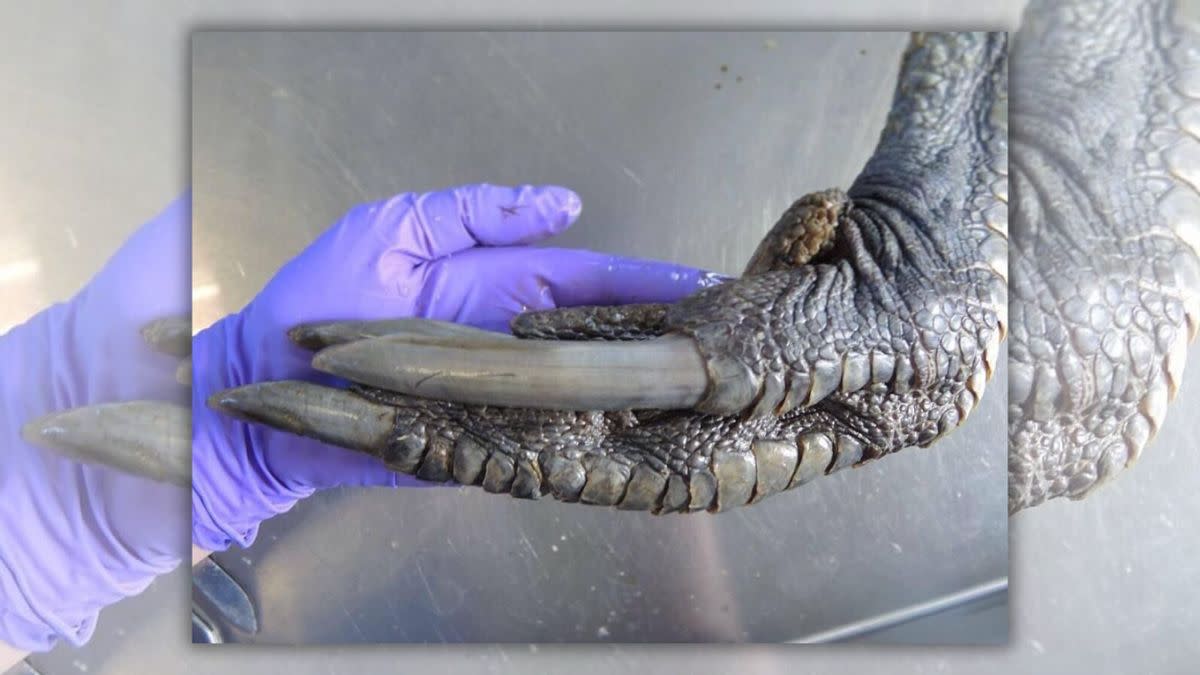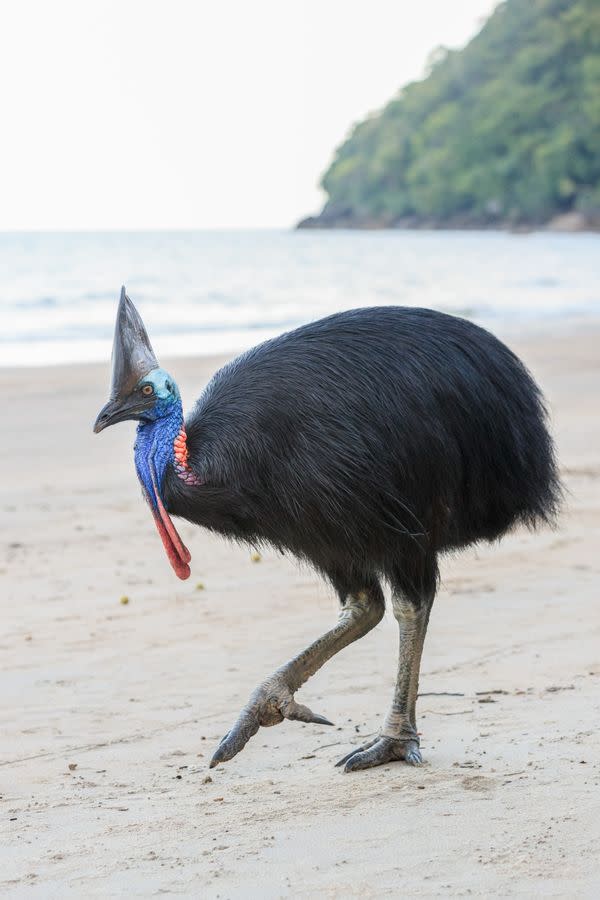Fact Check: Photo Allegedly Shows Gigantic, Dinosaur-Like Bird Claw. Here's What We Found

Claim:
A viral photograph shows a real, giant bird's claw.
Rating:
On May 25, 2024, a photograph went viral on X allegedly showing a giant bird's foot, resembling that of a dinosaur. "A Southern Cassowary claw. Just in case you didn't think that birds are dinosaurs," read the caption on the post, which had more than 15.9 million views as of this writing.
A Southern Cassowary claw. Just in case you didn't think that birds are dinosaurs pic.twitter.com/1q9V1rIQxv
— Nature is Amazing ☘️ (@AMAZlNGNATURE) May 25, 2024
Google reverse-image search results showed that the photograph also circulated on 9GAG, Instagram and Reddit. "The foot of a Male Southern Cassowary, the world's most dangerous bird, which sports massive claws that could easily disembowel a full grown man," one post read.
In short, because the viral photograph authentically showed a claw of a male southern cassowary, we have rated this claim as "True."
The photograph was first shared on Jan. 15, 2019, by Sarah Davis, then a doctoral candidate at the University of Texas at Austin. "Holding the claws of a male southern cassowary… Just in case any of your friends still need convinced that 🐦 = 🦖! ," she wrote, adding the hashtag #birdsaredinosaurs.
Holding the claws of a male southern cassowary... Just in case any of your friends still need convinced that 🐦 = 🦖! #gradschool #PhDlife #Paleontology #dinosaurs #birdsaredinosaurs pic.twitter.com/L6vYwyXmyx
— Sarah Davis (@PaleoFeathers) January 15, 2019
In later posts, Davis added that the bird "died of natural causes after a long and healthy life. He's now being used to study avian anatomy, color, and feathers as part of multiple graduate research projects." She also wrote that "cassowaries are native to Papua New Guinea and Australia, and are fruit eaters. But, that doesn't mean they don't know how to use those impressive claws..."
I feel incredibly humble to be able to work with such a magnificent bird. Cassowaries are native to Papua New Guinea and Australia, and are fruit eaters. But, that doesn’t mean they don’t know how to use those impressive claws...
— Sarah Davis (@PaleoFeathers) January 16, 2019
In January 2019, popular science website Live Science published an article on the topic, titled "Why This Enormous, Scaly Foot Looks Like It's from a Dinosaur," that included comments from Davis on the viral photograph. Davis told Live Science she studied "avian and nonavian dinosaurs, and analyzing modern birds provides valuable insights into the anatomy of extinct dinosaurs":
For this project, Davis and other students were dissecting the cassowary to compare its anatomy with the anatomy of other flightless terrestrial birds, "particularly ostriches and emus," described in published studies, she said.
"In this case, we are only looking at closely related species and looking for subtle differences in their legs," Davis said. Cassowaries, ostriches and emus are all flightless, but their lineages lost the ability to fly independently of each other. Clues to those divergent evolutionary pathways might be retained in subtle variations in their leg muscles. "Those differences are what we are looking for," she said.
…
"Cassowaries won't hesitate to kick at animals — and people — if they think they're threatening them, and the claw is a very effective tool for self-defense," Davis said.
The exceptional size and heft of the foot also invoked "a very dinosaurian feeling" — a perspective that Davis wanted to share, she added.
Davis also said she wanted her post with the picture to "awaken curiosity in people about the relationship between dinosaurs and birds," adding that "birds are living dinosaurs, and the dinosaurs we see today are equally as interesting as those that went extinct at the end of the Cretaceous."
Researchers have found that modern-day birds are descendants of dinosaurs, specifically the theropods.
"Birds that fill the world's skies today are living dinosaurs, reminders of a distant and strange past. Decades of major new discoveries and studies have convinced researchers that there's a direct link between modern bird species and theropod dinosaurs," according to London's Natural History Museum. "Many features and behaviours that characterise living birds were also found in their dinosaur ancestors. Perhaps most surprising of all was the discovery of dinosaurs with feathers. It completely changed the scientific community's perception of their appearance and behaviour."
Numerous articles about the southern cassowary draw attention to the bird's claws.
Encyclopedia Britannica wrote that the southern cassowary (Casuarius casuarius) inhabits New Guinea, nearby islands and Australia: "The cassowary has been known to kill human beings with slashing blows of its feet, as the innermost of its three toes bears a long daggerlike nail."
Similarly, Australia's Queensland Government website warned that "southern cassowary behaviour is unpredictable. Cassowaries can inflict serious injuries to people and pets by kicking with their large clawed feet."
"They're most active at twilight, have a claw that rivals Freddy Krueger's, and are one of the few bird species that have killed humans — but don't write off this flightless cousin of the emu as a thing of nightmares," a World Wildlife Fund article on the topic read. "Unprovoked, cassowaries are fairly shy and peaceful, and they play an important role in their tropical forest ecosystem."
Below you can see a photograph of a female southern cassowary on the beach in Etty Bay, Queensland:

(Getty Images)
This isn't the first time we've fact-checked a bird-related claim. For instance, in April 2024, we investigated whether owl chicks sleep face down because their heads are too heavy. In July 2022 we debunked a false claim that cedar waxwings die when their mates do.
Sources:
Cassowary | Description, Size, & Facts | Britannica. 10 May 2024, https://www.britannica.com/animal/cassowary.
"Southern Cassowary." The Australian Museum, https://australian.museum/learn/animals/birds/southern-cassowary/australian.museum/learn/animals/birds/southern-cassowary/. Accessed 29 May 2024.
---. "The Living Dinosaurs." The Australian Museum, https://australian.museum/learn/dinosaurs/the-living-dinosaurs/australian.museum/learn/dinosaurs/the-living-dinosaurs/. Accessed 29 May 2024.
Mindy Weisberger. "Why This Enormous, Scaly Foot Looks Like It's from a Dinosaur." Livescience.Com, 26 Jan. 2019, https://www.livescience.com/64600-cassowary-foot-photo.html.
Queensland;, c=AU; o=The State of. Southern Cassowary | Living with Wildlife. https://www.qld.gov.au/environment/plants-animals/animals/living-with/southern-cassowary. Accessed 29 May 2024.

 Yahoo News
Yahoo News 

